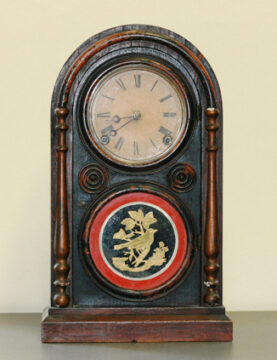
This month Rosenberg Library exhibited an antique Ingraham Co. mantle clock from its museum collection. The clock was a gift of the estate of Agness Peel Fox.
E. Ingraham & Company History
In 1860, clockmaker Elias Ingraham (1805 – 1885) established the firm E. Ingraham & Co. in Bristol, Connecticut. Between 1853 and 1873, Ingraham was awarded seventeen patents, all of which related to the designs of clock cases as opposed to the design of the clock’s inner workings.
A unique feature of Ingraham clocks were the figure-eight shaped cases. Early designs were referred to as “Gothic” clocks. These had rounded or pointed tops with “steeples” on either side of the dial. Later versions included decorative elements such as columns and rippled molding. More elaborate clocks were enhanced with paint, mother-of-pearl accents, or gilt columns in a Venetian or Grecian style.
Another signature design produced by Ingraham were black mantle clocks, such as the one at Rosenberg Library. Ingraham’s son, Edward, developed and received a patent for a method of applying black enamel paint to wood clock cases. This technique, called “Japanning,” produced an inexpensive imitation of French marble mantle clocks and often featured Chinese motifs.
In 1887, the growing firm expanded into a new 300 foot, 4-story structure. In 1913, the company began producing pocket watches in addition to clocks. During the 1930s, wrist watches, electric clocks, alarm clocks, and timers were added to its line of timepieces.
After more than a century of operation, E. Ingraham & Company closed in 1967.
A Gift of Agness P. Fox
Galveston residents Milo and Agness Fox were longtime supporters of Rosenberg Library who provided funds to establish and maintain a space in the Library to house its valuable collection of rare books. Formally dedicated in December 1967, the Fox Room was furnished with antiques from the Fox residence (1502 Market) including the Ingraham mantle clock.
To ensure its long-term preservation, the Rosenberg Library’s rare book collection was later moved into a climate-controlled storage vault in the Moody Wing. The Fox Room was subsequently converted into a beautiful meeting space available for public use.